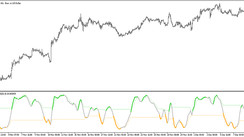Trading on volume is a technical analysis strategy that uses the volume of shares traded to identify trends and opportunities in the market. By tracking the volume of shares traded, traders can gain insights into the overall sentiment of the market and the strength of a particular trend.
How it works
When a stock or other financial instrument is in high demand, the volume of shares traded will increase. This is because more buyers are entering the market, which drives up the price. Conversely, when a stock or other financial instrument is out of favor, the volume of shares traded will decrease. This is because there are fewer buyers in the market, which drives down the price.
Traders can use the volume of shares traded to identify trends and opportunities in the market. For example, if the volume of shares traded in a stock is increasing while the price is also increasing, this is a sign that the trend is likely to continue. Conversely, if the volume of shares traded in a stock is decreasing while the price is also decreasing, this is a sign that the trend is likely to reverse.
How to identify market volume
There are a few different ways to identify market volume. One way is to look at the volume column on a stock chart. This column will show the number of shares that have been traded for each day. Another way to identify market volume is to use a volume indicator. Volume indicators are technical analysis tools that measure the volume of shares traded. Some popular volume indicators include the on-balance volume (OBV) indicator and the Chaikin Money Flow (CMF) indicator.
Expert opinion
Many experts believe that trading on volume is a valuable technical analysis tool. They argue that volume can provide valuable insights into the overall sentiment of the market and the strength of a particular trend. However, they also caution that volume should not be used in isolation. It is important to combine volume analysis with other technical analysis tools to make informed trading decisions.
What affects market volume
There are a number of factors that can affect market volume. Some of the most common factors include:
Economic news: Economic news can have a significant impact on market volume. For example, if the economy is doing well, we might see an increase in market volume as investors become more confident in the market. Conversely, if the economy is doing poorly, we might see a decrease in market volume as investors become more cautious.
Earnings reports: Earnings reports can also have a significant impact on market volume. If a company reports strong earnings, we might see an increase in market volume as investors buy shares in the company. Conversely, if a company reports weak earnings, we might see a decrease in market volume as investors sell shares in the company.
Institutional trading: Institutional investors, such as hedge funds and mutual funds, can also have a significant impact on market volume. These investors often trade large blocks of shares, which can lead to spikes in market volume.
Speculation: Speculation is another factor that can affect market volume. Speculation occurs when investors buy or sell shares based on their expectations of future price movements, rather than on the fundamentals of the company. Speculation can lead to increased market volume, especially during periods of high volatility.
Conclusion
Trading on volume is a valuable technical analysis tool that can be used to identify trends and opportunities in the market. However, it is important to remember that volume should not be used in isolation. It is important to combine volume analysis with other technical analysis tools to make informed trading decisions.





